
NC-4 Frank Bello – A bold New Design from Two of New York’s Biggest Bass Icons
Frank Bello, best known as the bassist of New York’s legendary thrash metal pioneers Anthrax, has joined forces with Spector Bass to develop an all-new instrument. Dubbed the NC-4 Frank Bello, this bass is inspired by both Spector’s rich history and iconic American bolt-on bass design.From its refined body contours and radiused top to the uniquely contoured neck heel, the NC-4 is built for speed, comfort, and stage-ready performance. Finished in a head-turning metallic purple affectionately named Tina Rose after Bello’s mother and grandmother and features a matching headstock, purple acrylic block inlays, and Bello’s signature EMG P/J pickup set.Furthermore, the NC-4 features a solid Alder body, a 1-piece Maple neck, and a Maple fingerboard – a tonewood trio that delivers the perfect blend of warmth, brightness, and clarity. The neck profile, modeled after Bello’s favorite vintage instruments, offers a slim, broken-in feel that’s instantly familiar.Finished with vintage-style chrome tuners, a modern adjustable bridge, and a brass nut for enhanced sustain, the NC-4 Frank Bello is ready to take on the world’s biggest stages – just like its namesake.“Spector is known for quality. My signature bass is built for players and offers incredible tone, comfort, and affordability. From the neck profile to the woods, signature EMG pickups, and brass nut, this is my ultimate go-to for any gig, Anthrax or other.” – Frank BelloThe NC-4 Frank Bello is more than a signature model – it’s a statement. Available now at authorized Spector dealers worldwide.$1499.99 US Street Price
Read more »
Zep to Pink Floyd to Steely Dan: Guitar World’s Jimmy Brown plays six riffs that changed his life
From Yes to Zep to Steely Dan to Pink Floyd, Jimmy Brown — Guitar World magazine’s longtime senior music editor — plays and discusses some of the now-classic guitar riffs…
Read more »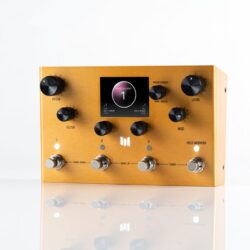
Meris Enzo X Review
For many of us, an electric guitar is as much a sound-design tool as a melodic vehicle. On the days and weeks when I can’t seem to coax a song or hook from my guitar, I love the release of just making noise, loops, and atmospheres that can bring me back around to the guitar as a conduit for melody. Meris’ Enzo X—which, on many nights, left me rapt in one of these less-self-conscious states—is more than a noise machine. Much more. In fact, it’s a very capable instrument in its own right: a polyphonic input synthesizer that also happens to work brilliantly with guitar and bass. And whether you’re looking for an elusive song’s magic side door or scoring a movie, Enzo X can crack open new states of guitar consciousness.First, though, a word for those inclined to dive into a pedal like this recklessly: Figuring out how to save and recall presets is essential. Like any interactive synth stacked with many possible tone and mood departure points. It’s easy to get lost, forget where you came from, or lose track of the sonic gold you find in your meanderings. And there is indeed gold to uncover here.Scare TacticsMany of the sounds you can trigger with your guitar (or any instrument, for that matter) will be recognizable as cousins to classic analog synths. Working from factory presets, I found voices evocative of Minimoogs and ARPs as well as triggers for cool sequencing and arpeggiating effects. A player’s inner John Carpenter can run wild among these voices. (Try preset 52, “poly 77 artic” for a start.) And as I absentmindedly re-tracked The Thing in my head, I ended up really pleased—and creeped out—with the sounds I found in the chase.More relatable guitar-oriented effects are here as well. There are many odd but operationally accessible phasers and envelope effects, to name a few. But the big fun is in probing the synth’s voices and working through how your playing adapts to each voice’s performance envelope. Many, for instance, rely on pitch or envelope triggering, which, at times, effectively deconstructs the fretboard and your sense of touch dynamics. Sometimes that yields frustration. But if you’re receptive to what the Enzo X gives back, you can open up pathways that reshape your sense of phrasing and timing and push back at your most obvious tendencies.The VerdictThe Enzo X isn’t exactly easy to operate, but it isn’t unintuitive, either. The interface and menu design are inventive, functional, and, after some practice, pretty fluid. By the time I found my own creative orientation toward the pedal’s many powerful sounds, I’d achieved a fast-paced rhythm for working within the controls. At $599, the Enzo X is an investment. And it probably won’t be an automatic fit for most guitarists that are song-oriented in the most formal, familiar sense. But for the right player, the Enzo X could easily yield more musical return than another electric guitar or several pedals at the same price
Read more »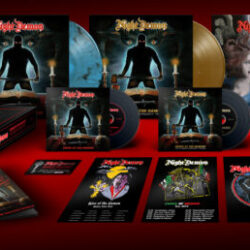
Q&A: Jarvis Leatherby on Night Demon’s Curse of the Damned box set
Night Demon bassist/vocalist Jarvis Leatherby discusses the band’s upcoming limited release 10th anniversary Curse of the Damned box set.
The post Q&A: Jarvis Leatherby on Night Demon’s Curse of the Damned box set appeared first on Decibel Magazine.
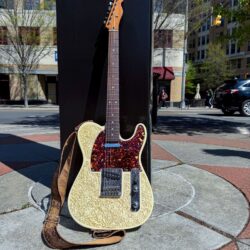
Laser-Engraved Paisley Transforms a Classically Configured T-Style
Fancy filigree distinguishes a reader’s ideal manifestation of straight-ahead Telecaster essence.Reader: Charlie KramerHometown: Arlington, VirginiaGuitar: CAM Custom Guitars T-StyleI’ve wanted a great Telecaster forever. I bought my first one back in the 1990s and I’ve owned five or six T-styles since, including Fenders, Squiers, G&Ls, and various knockoffs. None of them had everything I was looking for: twang with body, great playability, big frets, and a just-beefy-enough neck—something that could switch between rock and country like a boss. I’m picky; I’ve played guitar since the ’70s—gigging and recording actively—and, in that time, owned a couple dozen guitars from off-the-rack instruments to vintage Fenders and Gibsons, pawnshop weirdos, and some custom made ones, too. But if a guitar doesn’t speak to me, it gathers dust and then goes on Reverb.
A while back, my friend Chris Moreau at CAM Custom Guitars was cooking up something special. Chris made a couple guitars for Tracii Guns of L.A. Guns, so he knows his stuff. He also made a superb Flying V-style that my wife gave me as a Father’s Day gift a few years back.
Chris put together this T-style with an alder body, a roasted maple neck with Jescar stainless-steel frets sourced from Havok Guitars, Fender Pure Vintage ’64 Telecaster pickups, and an engraved Wanby bridge and control plate. Then, Greg Wells at DoubleU Design Studio in Falls Church, VA, burned an amazing paisley design into the top with a Glowforge laser engraver.“When plugged into a cranked amp, it could move from Waylon Jennings to Jimmy Page by just adjusting the volume and tone knobs.”I watched with envy when Chris listed it for sale, and I had to play it before he sold it! But as soon as I had it in my hands, I had to have it. It rang like a piano, and when plugged into a cranked amp, it could move from Waylon Jennings to Jimmy Page by just adjusting the volume and tone knobs. The big stainless frets made bends smooth and easy. I wrote him a check and got out of there with my new prize.Since then, it’s been one of my main gigging and recording guitars. I used it on a demo for my band Mother of States and played it onstage with the Vaping Nuns (a band I play in with Chris and Greg). When I’m taking a break from work or want to run scales, it’s my go-to instrument—always just a few feet from my desk. Finally, I have the T-style of my dreams!
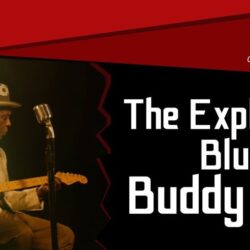
Nobody Can Keep Up with Buddy Guy | 100 Guitarists Podcast
Buddy Guy’s high-energy, crowd-strolling performances set the bar for every electric blues and blues rock guitarist who came after him. And that includes Jimi Hendrix. Buddy changed the game and left an indelible mark on the sound of electric guitar playing. He’s still out there, delivering incendiary performances to stages all over. On this episode, we’re talking about one of the last blues guitar showmen, whose polka dot signature Strat caught both of our eyes. Where’s the best place to start? And where did Buddy get all that energy?Thanks to our Sponsor, Xvive!LEARN MORE! https://xvive.com/
Read more »Full EP Stream: Frusen Sorg – “Jag Springer Med Avbrutna Ben”
Swedish duo Frusen Sorg rip through eight minutes of blackened crust punk on their new EP.
The post Full EP Stream: Frusen Sorg – “Jag Springer Med Avbrutna Ben” appeared first on Decibel Magazine.
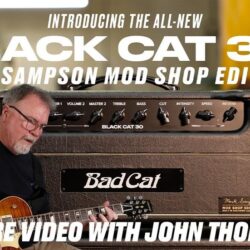
Bad Cat Launches Mod Shop Black Cat 30 Head and Combo
Bad Cat Amplifiers has introduced the Mod Shop Black Cat 30 Head and Combo—the debut models from its new Mod Shop series and one of the final amplifier projects touched by Mark Sampson.Before his passing, Sampson—co-founder of the boutique amp movement and one of the most respected circuit designers in the industry—collaborated with Bad Cat on a number of designs. Among them was a fresh take on the award-winning Black Cat. The result is a limited amplifier that blends Bad Cat’s signature character with a bigger, bolder voice, infused with Sampson’s distinct approach to tone shaping.Key Features:30 watts of EL84 Power – Four EL84s provide signature Class A chime, natural compression, and harmonic richness.All-new tone stack – Revoiced by Sampson for enhanced openness and dimension.Two independent channels – A rich, dynamic clean channel and a punchy, articulate overdrive.Studio-quality reverb and analog bias-modulated tremolo – Lush, vintage-inspired depth and movement.Built for real-world use – Buffered effects loop, multiple speaker outputs, and a direct line out for cab sims or IRs.Handcrafted in Costa Mesa, California, the Mod Shop Black Cat 30 is built with premium components, custom hand-wound transformers, and a level of detail worthy of the Mod Shop name.Combo Specs:Custom UK-made 12” Celestion Bad Cat speakerDimensions: 23.75”W x 10.375”D x 19”HWeight: 48 lbs.Head Specs:Dimensions: 20.75”W x 10.375”D x 10”HWeight: 31 lbs.Both versions include a two-button footswitch (Channel Select and Tremolo) and come with a 3-year limited warranty.The Mod Shop Black Cat 30 Head and Combo are available now and carry street prices of $2299 and $2499 respectively. To learn more or place an order, visit www.badcatamps.com
Read more »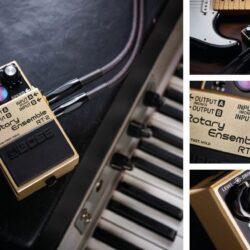
BOSS Announces RT-2 Rotary Ensemble
BOSS announces the RT-2 Rotary Ensemble, the latest member of the company’s famous compact pedal lineup. Rotary speaker cabinets are a vital part of the classic combo organ voice, and guitarists and other musicians have also used them to infuse iconic tracks with their distinctive depth and rich modulation. Powered by the latest BOSS advancements, the RT-2 distills this expressive spatial effect into a pedalboard-friendly footprint with three sound modes, deep tonal shaping, multiple audio output configurations, and advanced real-time sound control. The most revered rotary speaker designs feature a spinning high-frequency horn (treble rotor) and a woofer that feeds into a rotating drum (bass rotor). Changing rotor speeds between fast and slow creates a steady stream of tonal shifts that players have long used for interesting sonic movement. The RT-2 authentically replicates these complex audio behaviors, coupled with two-way speed control, a Rise/Fall Time switch for adjusting the transition time between speeds, and a colorful indicator that shows the current rotation of the virtual rotors.The versatile RT-2 has a three-position Mode switch for selecting a classic rotary speaker sound or two modern variations developed with custom BOSS tuning. There’s also a Drive knob to add pleasing distortion inspired by the tube amplification circuits in vintage rotary speaker cabinets. Via a rear-panel switch, this dual-function control can be assigned to adjust the volume balance between the treble and bass rotors for different tonal characteristics.Real-time speed control is essential to the rotary experience, and the RT-2 includes many options to achieve it. The pedal switch offers four operation types with clever ways to bypass the effect and change speeds while performing. Connecting external footswitches provides independent speed control and access to a “brake” setting that stops the virtual rotors at their current positions for unique tones. Alternately, an expression pedal unlocks continuous control of level, drive, balance, and speed, complete with assignable settings for each parameter.To learn more about the RT-2 Rotary Ensemble, visit https://www.boss.info.Availability & PricingThe BOSS RT-2 Rotary Ensemble will be available in July 2025, for $239.99.
Read more »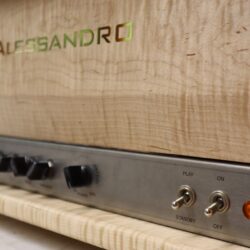
George Alessandro Asks: Are You Using Your Amp’s Standby Switch Correctly?
“To standby or not to standby, that is the question”Are you using your standby switch correctly? Are you sure? It might be a little different than you think.You have your on/off switch and, well, that makes sense. But standby? Okay, well, what is the flip side? In a tube guitar amplifier, it is “play.” Isn’t the flip side of “off” also play? Why are there two switches that do basically the same thing? Vacuum tube amps are a very old electronic technology, and there is a specific function for each of the two switches. The on/off switch controls power to the entire amplifier by switching the line voltage on or off to the power transformer. The power transformer is the distribution hub for the energy inside the amp. If your amp doesn’t have a standby switch, then once you switch it on, all the energy is on inside the amp all at once. This isn’t a good thing for vacuum tubes. They need to warm up before they can function, which is why you get no sound from a tube amp when you first turn it on. Tubes only need about 45–60 seconds to warm up to function, but they do sound different and “better” once they get up to operating temperature. This can take five to 10 minutes, and once you actually start playing the amp and they get cooking, even more time to get that tone!So the standby switch has a few functions. At cold start up, it allows the tubes time to warm up before applying the high voltage to them to operate the amp. While the amp is at operating temperature, if you are taking a break, it allows the amp to also take a break while maintaining operating temperature. And at the end of the session, it allows you to discharge the energy inside the amp. Here are the times you’ll use that switch:Cold startWith the standby on, turn the power switch on. Allow the amp to warm up for a minute, then flip the standby to “play” position. There is no issue with waiting more than a minute, but shorter is bad. There is this thing called cathode stripping that happens when you apply voltage to a tube before it is fully warmed up.In between sets or just taking a break.You probably know how hot your amp gets when you’re jamming away. This is okay; tubes run on high temperatures, but all the other parts inside, not so much. So, give the amp a break. When you’re taking a break, switch to standby position. This keeps the tube warm but allows the entire amp to cool down. This also takes the high voltage off the circuit, so the parts’ life clock is put on hold, too. If you’re going for a long break, an hour or more, you can do a full shutdown and start from the cold-start procedure. Otherwise, you’re just wasting energy heating the tubes and the heaters do have a life span.Shut down.So far, it’s likely everything seems obvious. But here’s where people can get it wrong: It’s the end of the night, and you’re drained and done. Well, your amp wants to be too! Shutdown is a slightly different procedure than taking a break and allows the amp to drain all its stored voltages. After that last note, flip that on/off switch onto the off position. You can audibly hear the energy drain out of the amp as the last of the high voltage is dissipated by the tubes trying to operate, because the standby switch is still in the play position. The off position shuts down the heaters inside the tubes and the high voltage, so the last of the energy stored by the caps can drain out while the tubes are still hot. When you hear the last of that sound dissipate, the voltage inside is drained, and you can put the standby switch onto standby. Now, the amp is ready for the cold start up procedure.What about amps that don’t have standby switches? They don’t need it. The Princeton Reverb, for example, doesn’t have a standby switch, but it does have a 5AR4 rectifier tube. The 5AR4/GZ34 tube has a controlled warm up. While the tube is cold, it will not pass high voltage for a set amount of time, about 45 seconds. This controlled warm up allows all the tubes in the amp to get warm before the high voltage comes on. So, it does the waiting to go from standby to play for you. You don’t have the take a break option anymore, so it is best to shut it down when taking long breaks. It automatically does the cold turn on and aforementioned shut down procedure. But if your amp has a standby switch, use it!
Read more »